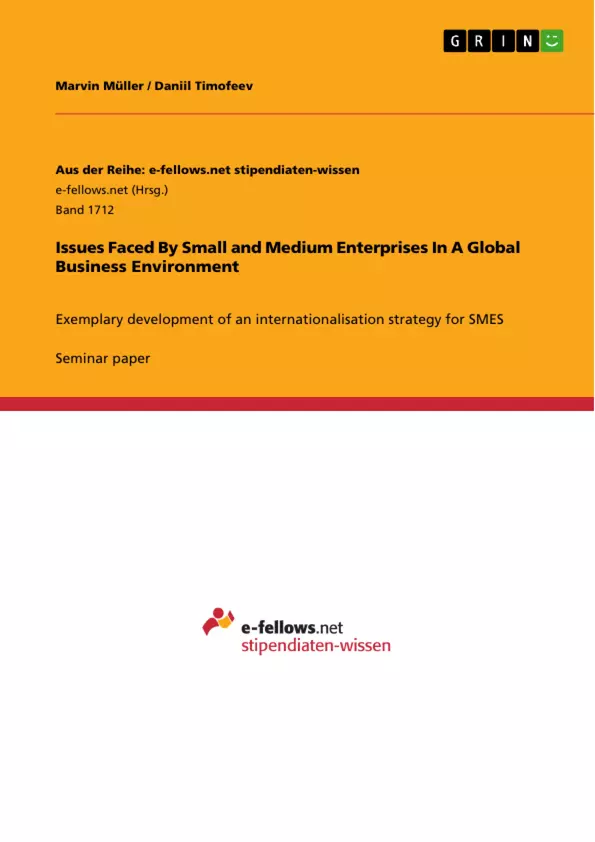The paper aims to analyse the current situation of a fictive company and moreover to work out an adequate internationalisation strategy considering the following three key objectives: 1. Reduce labour costs by shifting the production- centre to a low-income country, 2. Enter new markets in countries with a low level of market satisfaction, 3. Enlarge the range and variety of products through a highly educated R&D-Team.
After evaluating the business environment, three potential target countries for the internationalisation process are assessed. In a next step the strengths, weaknesses, opportunities and threats are lined out. Moreover a PEST-analysis is conducted to prepare for the location decision. Finally, the most adequate method is selected and a brief conclusion and recommendation are given.
Inhaltsverzeichnis (Table of Contents)
- 1. Introduction
- 1.1 Problem and Objective
- 1.2 Analytical Structure
- 2. Current and Future Business Environment: STEEP-Table
- 3. Internationalisation Strategy
- 3.1 Country Selection
- 3.2 SWOT-Analysis
- 3.3 PEST-Analysis
- 3.3.1 Weighting System
- 3.3.2 Data Analysis
- 3.3.3 Location Decision
- 3.4 Choice of Method
- 4. Conclusion and Recommendations
- 5. Appendices
- 6. References
Zielsetzung und Themenschwerpunkte (Objectives and Key Themes)
The main objective of this work is to analyze the current situation of Elecdyne, a Japanese SME operating in the electronics sector, and develop an adequate internationalization strategy to address its declining sales and profitability. This strategy aims to achieve three key objectives: reducing labor costs by relocating production, entering new markets with low market satisfaction, and expanding the product range through a strong R&D team.
- Internationalization strategy for a Japanese SME in the electronics sector
- Analysis of the business environment using STEEP, SWOT, and PEST frameworks
- Evaluation of potential target countries for relocation and market entry
- Decision-making process based on weighted criteria and analysis of macroeconomic factors
- Recommendations for implementation and future development
Zusammenfassung der Kapitel (Chapter Summaries)
- Chapter 1: Introduction
- Chapter 2: Current and Future Business Environment: STEEP-Table
- Chapter 3: Internationalization Strategy
This chapter introduces Elecdyne, a Japanese SME facing declining sales and profitability due to high labor costs, licensing fees, and difficulties in hiring qualified research staff. The chapter outlines the company's need for restructuring and an effective internationalization strategy to address these challenges. The three key objectives of the internationalization strategy are presented, aiming to reduce labor costs, enter new markets, and expand the product range.
This chapter analyzes the current and future business environment of Elecdyne through a STEEP analysis. It examines factors such as global population growth, changing religious profiles, increasing technology adoption, and economic trends. This analysis aims to provide context for the company's internationalization strategy and identify potential opportunities and threats.
This chapter focuses on the development and implementation of Elecdyne's internationalization strategy. It includes the selection of potential target countries, a SWOT analysis to assess the company's strengths, weaknesses, opportunities, and threats, and a detailed PEST analysis to examine the political, economic, social, and technological factors influencing the chosen locations.
Schlüsselwörter (Keywords)
This work primarily focuses on the internationalization strategy of a Japanese SME in the electronics sector. The key terms and concepts include STEEP analysis, SWOT analysis, PEST analysis, country selection, location decision, internationalization strategies, market entry, production relocation, and R&D development. The analysis uses various frameworks and data to assess the macroeconomic environment and provide recommendations for the company's future growth.
- Quote paper
- Marvin Müller (Author), Daniil Timofeev (Author), 2016, Issues Faced By Small and Medium Enterprises In A Global Business Environment, Munich, GRIN Verlag, https://www.grin.com/document/315561



